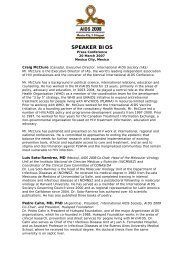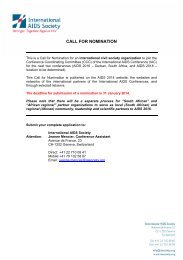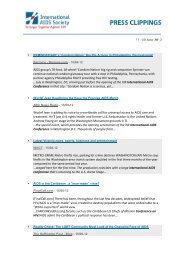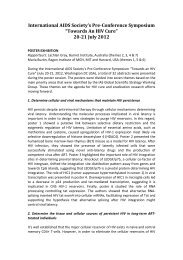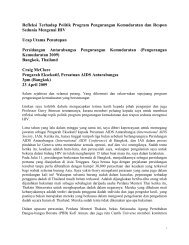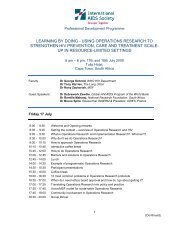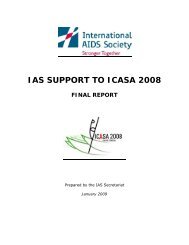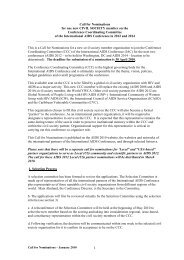Advocacy in Action - International AIDS Society
Advocacy in Action - International AIDS Society
Advocacy in Action - International AIDS Society
You also want an ePaper? Increase the reach of your titles
YUMPU automatically turns print PDFs into web optimized ePapers that Google loves.
ACTIVITY<br />
2.2 Objective: By the end of this session<br />
participants will be able to:<br />
1. Understand the issue or problem<br />
2. Identify 2-3 possible advocacy solutions and<br />
gather <strong>in</strong>formation that supports their analysis<br />
Section 2.2 Step 2: Analyse and gather <strong>in</strong>formation on the issue or problem<br />
38<br />
Introduction<br />
• We identified advocacy issues <strong>in</strong> Step 1. Now we need to analyse our issue, f<strong>in</strong>d<br />
<strong>in</strong>formation about it and suggest possible solutions.<br />
• It takes time to analyse a problem, agree possible solutions and collect documentation and<br />
evidence on the problem – but it is time well used.<br />
• Analysis, documentation and <strong>in</strong>formation can be used:<br />
♦ To <strong>in</strong>fluence and <strong>in</strong>form targets and allies<br />
♦ To provide evidence for our position or those of others<br />
♦ To disprove statements by people who oppose us<br />
♦ To change perceptions of a problem<br />
♦ To disprove myths, rumours and false assumptions<br />
♦ To expla<strong>in</strong> why previous strategies have not worked<br />
• It is also important to <strong>in</strong>volve people who are directly affected by the issue or problem at<br />
this stage. They will have an <strong>in</strong>-depth understand<strong>in</strong>g of the problem and its effects, and will<br />
have ideas about how it can be solved. For example, participatory drama (<strong>in</strong>volv<strong>in</strong>g a<br />
discussion with the audience) or a cause-and-effect flowchart can be used to analyse<br />
issues and identify solutions with those affected.<br />
• It is important to consider carefully the effects of any suggested solutions – some proposed<br />
solutions can cause more problems than they solve!<br />
2.2 Step 2 Part A: Understand<strong>in</strong>g the issue or problem<br />
Instructions<br />
Tim<strong>in</strong>g: 1 hour<br />
1 Expla<strong>in</strong> the objectives of this step, <strong>in</strong>troduce the topic and the activity.<br />
2 Expla<strong>in</strong> how to create the cause-and-effect flowchart us<strong>in</strong>g a drawn completed example.<br />
Also give the follow<strong>in</strong>g k<strong>in</strong>d of <strong>in</strong>structions to the participants:<br />
a) Ask the groups to write the issue or problem they have selected <strong>in</strong> the middle of a big<br />
piece of paper. At the top of the paper write ‘Effects’, at the bottom write ‘Causes’.<br />
b) In the space below the problem, ask them to draw or write as many causes of the<br />
problem as they can th<strong>in</strong>k of. Draw an arrow from each cause to the issue or problem <strong>in</strong><br />
the centre. Causes can be people, organisations, attitudes, poverty, types of behaviour,<br />
lack of knowledge – anyth<strong>in</strong>g.<br />
c) Ask them to look at each cause and f<strong>in</strong>d deeper causes, by ask<strong>in</strong>g, ‘What causes that<br />
cause?’ They should add these causes of causes, connect<strong>in</strong>g them with arrows.<br />
d) Next ask the participants to write the effects of the problem <strong>in</strong> the top half of the paper.<br />
Draw an arrow from the problem <strong>in</strong> the centre up to each effect.<br />
e) Look at each effect and ask, ‘What further effect will that have?’ Add effects of effects,<br />
and connect them with arrows.<br />
3 After the groups have completed their cause-and-effect chart, ask them to look at the<br />
causes, and circle the ones that could be changed or improved with the help of <strong>in</strong>fluential<br />
people or <strong>in</strong>stitutions (i.e., the ones for which advocacy could be a solution).<br />
4 Ask the groups to select 2-3 possible advocacy solutions. When th<strong>in</strong>k<strong>in</strong>g of solutions, they<br />
can also use their previous experience or the experience of others who have worked on the<br />
same issue or problem. Another way to identify solutions is to ‘reverse’ a cause of the issue<br />
or problem – for example, if one cause of stigma is the silence of community leaders, a<br />
solution would be the opposite: for community leaders to speak publicly <strong>in</strong> support of<br />
people liv<strong>in</strong>g with HIV/<strong>AIDS</strong>.




